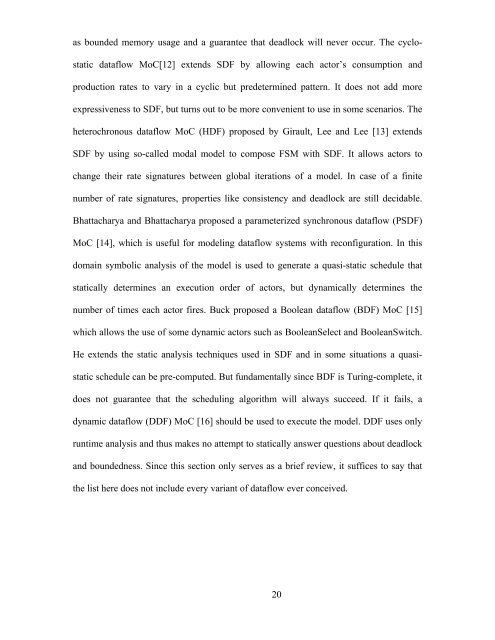Dynamic Dataflow Modeling in Ptolemy II - Ptolemy Project ...
Dynamic Dataflow Modeling in Ptolemy II - Ptolemy Project ...
Dynamic Dataflow Modeling in Ptolemy II - Ptolemy Project ...
Create successful ePaper yourself
Turn your PDF publications into a flip-book with our unique Google optimized e-Paper software.
as bounded memory usage and a guarantee that deadlock will never occur. The cyclo-<br />
static dataflow MoC[12] extends SDF by allow<strong>in</strong>g each actor’s consumption and<br />
production rates to vary <strong>in</strong> a cyclic but predeterm<strong>in</strong>ed pattern. It does not add more<br />
expressiveness to SDF, but turns out to be more convenient to use <strong>in</strong> some scenarios. The<br />
heterochronous dataflow MoC (HDF) proposed by Girault, Lee and Lee [13] extends<br />
SDF by us<strong>in</strong>g so-called modal model to compose FSM with SDF. It allows actors to<br />
change their rate signatures between global iterations of a model. In case of a f<strong>in</strong>ite<br />
number of rate signatures, properties like consistency and deadlock are still decidable.<br />
Bhattacharya and Bhattacharya proposed a parameterized synchronous dataflow (PSDF)<br />
MoC [14], which is useful for model<strong>in</strong>g dataflow systems with reconfiguration. In this<br />
doma<strong>in</strong> symbolic analysis of the model is used to generate a quasi-static schedule that<br />
statically determ<strong>in</strong>es an execution order of actors, but dynamically determ<strong>in</strong>es the<br />
number of times each actor fires. Buck proposed a Boolean dataflow (BDF) MoC [15]<br />
which allows the use of some dynamic actors such as BooleanSelect and BooleanSwitch.<br />
He extends the static analysis techniques used <strong>in</strong> SDF and <strong>in</strong> some situations a quasi-<br />
static schedule can be pre-computed. But fundamentally s<strong>in</strong>ce BDF is Tur<strong>in</strong>g-complete, it<br />
does not guarantee that the schedul<strong>in</strong>g algorithm will always succeed. If it fails, a<br />
dynamic dataflow (DDF) MoC [16] should be used to execute the model. DDF uses only<br />
runtime analysis and thus makes no attempt to statically answer questions about deadlock<br />
and boundedness. S<strong>in</strong>ce this section only serves as a brief review, it suffices to say that<br />
the list here does not <strong>in</strong>clude every variant of dataflow ever conceived.<br />
20
















